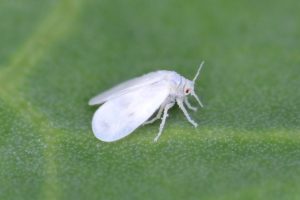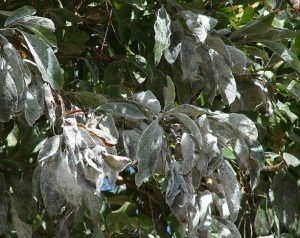 This tiny little insect called whitefly in the picture alongside is amongst the several insects who have developed resistance to many pesticides.
This tiny little insect called whitefly in the picture alongside is amongst the several insects who have developed resistance to many pesticides.
These tiny creatures can seem pretty but can be a huge nuisance as well. They have four broad wings that are held roof-like over the body and covered with a white powdery wax. Whiteflies leave a sticky substance that appeals to ants attracting more insects to the infested area. Whiteflies produce honeydew that becomes food for black sooty mold.
Most species with a wingspan of less than 3 mm and a body length of 1 mm to 2mm.Some “giant whitefly” species exist, some of which may exceed 5 mm in size. The insects and their wings are variously marked or mottled according to species, and many species are covered with fine wax powder, giving most species a floury, dusted appearance. The female whitefly deposits 30 – 500 small, cigar-shaped, yellowish eggs during her lifetime. These are attached to the undersides of the leaves.
There are over 1,500 different kinds of whiteflies. Their white color is due to a white, mealy wax coating over their body. Whiteflies penetrate the food-conducting tissue of the plant and help themselves to the plants nutrient supply. The biggest problem about whiteflies is the viral diseases they carry such as tomato yellow leaf curl. They suck the sap from the phloem tissue of the leaf, feeding greedily on the plant juices for about 3 to 5 weeks, depending on temperature and species. Under most conditions generations overlap and all stages of the insect may be found infesting plants at any time. These insects can greatly impact agriculture and spread disease, affecting food production all around the world when they feed. While they will affect food, their presence will also influence the larger economy, costing farmers and consumers a lot of money by driving up food prices.
 Viruses carried by whiteflies infect many important agricultural crops such as tomato, cotton, citrus, and beans. Ornamental plants attacked by whiteflies include Bradford pear, pomegranate, ficus, gardenia, hibiscus, banana, fushia, iris, gladiolus, lantana and many more.
Viruses carried by whiteflies infect many important agricultural crops such as tomato, cotton, citrus, and beans. Ornamental plants attacked by whiteflies include Bradford pear, pomegranate, ficus, gardenia, hibiscus, banana, fushia, iris, gladiolus, lantana and many more.
The color yellow attracts whiteflies. Whiteflies feed by tapping into the phloem of plants, introducing toxic saliva and decreasing the plants’ overall turgor pressure. Since whiteflies congregate in large numbers, susceptible plants can be quickly overwhelmed. Further harm is done by mold growth encouraged by the honeydew whiteflies secrete. This may also seriously impede the ability of farms to process cotton harvests.
The nuisance caused by the whiteflies is reported in the below news articles:
KARNATAKA: INVASION OF THE WHITEFLIES
Bangalore Mirror Bureau | Updated: Dec 9, 2017
Several parts of Kerala and coastal Karnataka have been affected by Rugose Spiraling Whitefly
Several coconut plants in the coastal region including Kerala have been affected by the invasive pest Rugose Spiralling Whitefly (Aleurodicus rugioperculatus Martin). This pest was first reported in India from Pollachi in Tamil Nadu and Palakkad in Kerala in July 2016.
Dr Vinayaka Hegde, Principal Scientist (Plant Pathology) and Head, Division of Crop Protection, ICAR- Central Plantation Crops Research Institute (CRCRI), Kasargod in Kerala said, “Rugose spiralling whitefly (RSW) adults can be distinguished by their large size and the presence of a pair of irregular light brown bands across the wings. RSW was first described by Martin in 2004 from samples collected in Belize on coconut palm leaves and subsequently in Florida from Miami-Dade County in 2009.”
Tehran’s Whiteflies Again Out of Control
Thursday, September 14, 2017
Tehran’s whitefly population has got out of control once again, causing serious exasperation to residents.
Whiteflies have been a summertime nuisance for the past few years, Jamejam Online reported.
Mohammad Baqer Qalibaf, the former Tehran mayor, is widely blamed for the failure to implement effective measures during his tenure to control these insects.
The most noticeable move to address the problem so far has been the use of yellow sticky plastics on the barks of trees, which has apparently borne no fruit.
Spraying urban trees and bushes with pesticides in all seasons is reportedly the most effective way of curbing the problem.
However, Farideh Olad-Qobad, Tehran’s representative in the parliament, believes that the method has not been implemented at all this year or has been done haphazardly.
“All the measures taken by the municipality to tackle this problem have failed so far,” she said.
The above news articles clearly state the severity of the damage caused by the whiteflies and the ineffectiveness of the measures used to keep the whiteflies away. There is a need for an effective solution to keep these flies at a bay and such a solution is available with C Tech Corporation.
Combirepel™ an anti-insect additive, a C Tech Corporation product is an ideal solution for the prevention and control of whitefly infestation. The masterbatch of Combirepel™ can be incorporated in agricultural films, irrigation tubes, wires, and cables, etc. and other polymeric appliances.
Combirepel™ liquid concentrate which can be mixed in paints and can be applied as a topical application near the areas of infestation. It can be applied on the concrete fences around farms and gardens. It can be used in the areas of storage used to store agricultural and garden produce.
While Combirepel™ lacquer can be used as a topical application which can be applied directly on a variety of surfaces. It can be applied to the tree trunks, metal fences, polymeric equipment etc.
Combirepel™ is an extremely low-toxic and extremely low-hazardous anti-insect additive. It is thermally stable and does not degrade on exposure to heat and sunlight. It does not kill or harm the insect but repels them. It does not volatilize and does not degrade the soil.
With our product, you can get an effective solution to combat the nuisance caused by different insects.
Contact us at technical.marketing@ctechcorporation.com to keep the pests away.
Also, visit our websites:
http://www.ctechcorporation.com/
http://www.rodrepel.com/
http://www.termirepel.com/
http://www.combirepel.com/
Follow our Facebook pages at:
1] https://www.facebook.com/Combirepel-411710912249274/
2] https://www.facebook.com/Termirepel-104225413091251/
3] https://www.facebook.com/Rodrepel-120734974768048/
Follow us on our Twitter pages at:
1] https://twitter.com/rodrepel
2] https://twitter.com/termirepel
3] https://twitter.com/combirepel
